Have you heard of inventory reconciliation? Did you, in the past, conduct inventory taking that involves reconciling your physical inventory against your system’s inventory record?
Do you feel exhausted because you just can’t keep up with your inventory transactions?
I am sure you have experienced this while managing your e-commerce business.
Well, this article is for you!
I have brought in this article my acquired knowledge and rich experience in supply chain so that you can understand those intricate details about managing inventory.
Inventory management is a process of receiving, storing, processing, picking or packing and eventually selling goods to end customers. This daily process of incoming and outgoing products inside your warehouse or fulfillment center involves the element of human intervention, which can cause your physical inventory quantity to be different from your inventory (system) records.
One of the clear signs of a healthy inventory is that there is an inventory reconciliation process in place and that all errors found during the product inventory count should be adjusted accordingly so that the physical quantity of the product is equal to the system’s inventory quantity.
Should you want to know more about inventory management, please check our guide on rolling out inventory management software.
What is Inventory Reconciliation?
I have been there before, after long tiring hours of counting your physical inventory, the next thing you should do is to determine if your physical quantity of products matches your system’s inventory record. It is ideal to have 100% inventory accuracy, meaning your physical product quantity exactly matches your inventory record quantity.
But if you have a difference in the result, your next step will be performing inventory reconciliation. Reconciling your inventory means aligning your product’s physical quantity to your inventory record. Basically, determine if the physical count of each of your products matches your inventory record.
To understand how inventory reconciliation works, see below sample of an inventory count result summary broken down by variance type:

You can see from the illustration the total physical count for each product alongside the inventory record for each SKU. Upon completing the inventory count and checking on the transaction record, we have identified the specific variance reasons (see last column).
Steps to Reconciling Inventory
Here is the approach I recommend if you have inventory difference:
Step 1: Organize your inventory
There are two things to prepare in order to organize stock inventory prior to counting:
- Physical arrangement of items. Organizing products according to items in their designated location can bring orderliness during physical counting, it will also make accounting of items more easy and efficient.
- Organize system inventory records. Validating, confirming and processing all pending transactions (in the system or in record) can help you have a clear insight of what is your current inventory balance. It is important to have this prepared prior to the actual accounting of products to minimize the discrepancy in the count result.
Step 2: Perform a physical count of products
Physical counting of products inside the warehouse or fulfillment center is conducted to account all the inventory balance stored in the warehouse.
Step 3: Capture your system balance
The same thing with physical counting, there should also be an accounting of products inventory balance in the system.
To be able to do this, there should be an identified timeline when to capture inventory balance where there are no transactions happening to have an accurate account of all the transactions.
Step 4: Match side by side your physical count and inventory record
To do this, you should be having both the physical count of products and inventory record finalized into an itemized summary. Compare both in terms of quantity. Ensure that both records of physical quantity and inventory quantity are finalized and have been validated to ensure that you can pinpoint the root cause of the inventory variance.
Step 5: Reconcile inventory
If there are differences between the physical and the inventory record, you may proceed to perform inventory reconciliation. Reconciling inventory may consist of aligning your system inventory records to your physical count. The rule of thumb is that whatever your actual physical count is, that is what your system record should be. Of course there should be accounting for products that have no physical product but with system balance. But since the actual product can be used in fulfilling a customer’s order, it is the one with actual physical count that will be followed.
Step 6: Perform Inventory Adjustment
After breaking down the root cause of the inventory difference, the one responsible for monitoring inventory transactions, usually called Inventory Specialist, should perform inventory adjustment. These are the types of variances you’ll encounter:
- Positive variance: This refers to the product inventory that is higher than the expected inventory quantity in the inventory record. Typically, this is called inventory overage where there are more actual product quantities than your inventory record.
- Negative variance: This refers to the product inventory being lower than the expected inventory quantity in the inventory record. The other term for this is product shrinkage where there are missing items or lost inventory.
- Product switching variance: This refers to the product inventory that is switched to another product that results in being short on one product but having excess quantity in another. This usually comes from picking errors in the warehouse operations.
Organizations or companies with high-value inventory typically require approval from stakeholders before adjusting inventory, because inventory management also impacts the financial statement of a business!
Inventory adjustment is simply adjusting the inventory quantity record based on the physical quantity checked. There are far more complicated inventory adjustments techniques concerning inventory if you are using WMS or Warehouse Management System because of the designated warehouse locations which can be tedious to reconcile. In the WMS-managed warehouse, not only SKU and quantity are checked, but also the location accuracy and batch code of each pallet inside the storage.
Step 7: Document any adjustments made
Depending on the type of movement, documentation of inventory adjustment should be made in order to officially make the transaction a valid record that is agreed by all stakeholders. Documentation shall also be signed by the stakeholders to indicate their concurrence on the inventory result and its adjustment. Inventory adjustments may be documented through the company’s established inventory adjustment form, receipt, invoice etc. These may also be used in a company’s profit and loss statement.
What are the possible causes of inventory variance?
Below I have listed the primary cause of inventory variance within the supply-chain operations, below are the list and their possible effect. If you have experienced these effects, you may want to work backward to identify the root cause. In the table below, I have listed down the possible causes and their corresponding effect with the suggested solution:
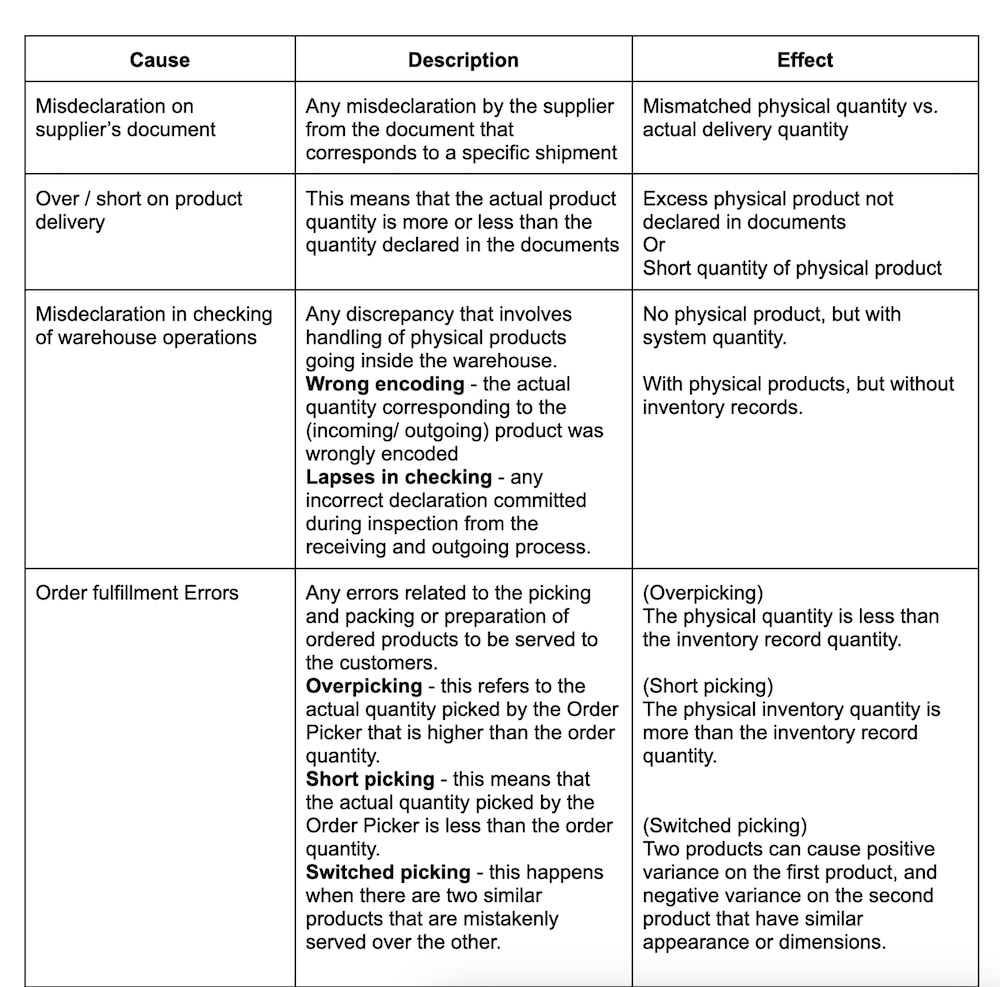
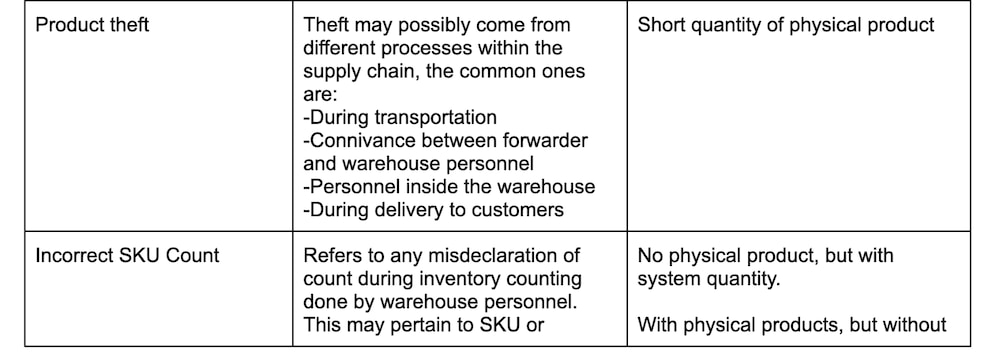
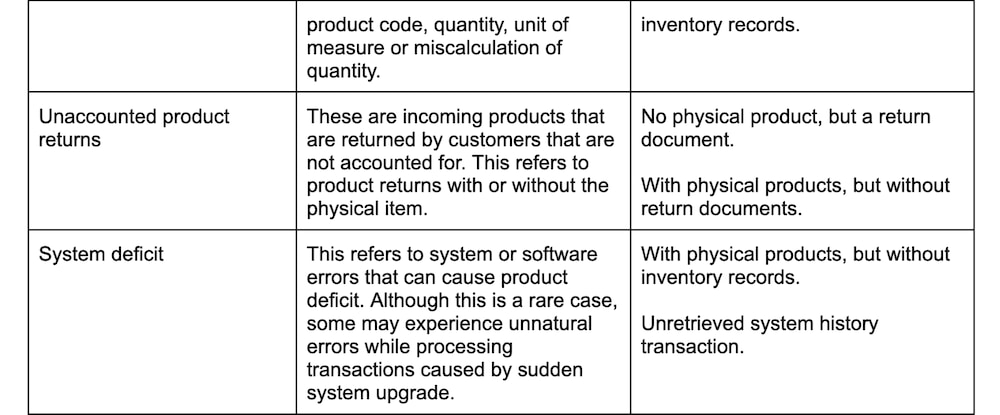
Where should you look when there is inventory difference?
I have listed below some of the common causes of inventory variance. These are not the absolute root cause of your inventory variance, these are just guidelines for you to follow in order to come up with the right place where variance originates. Supply chain operations and processes vary differently depending on its unique need. In my years of experience, these can be summarized into:
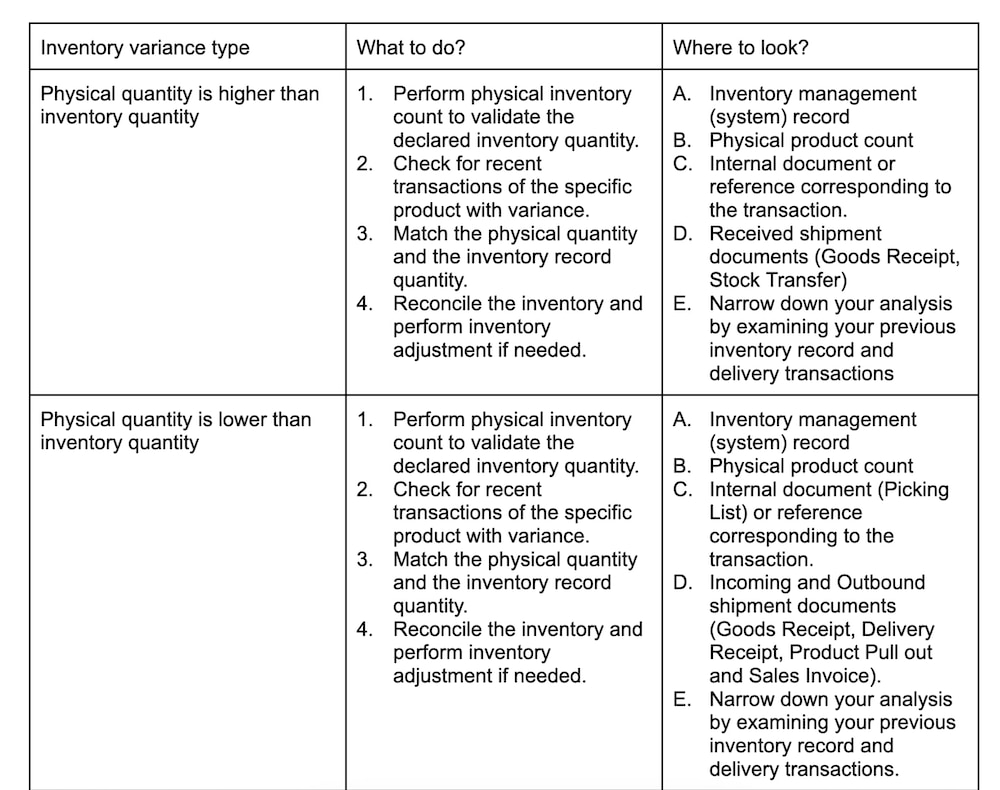
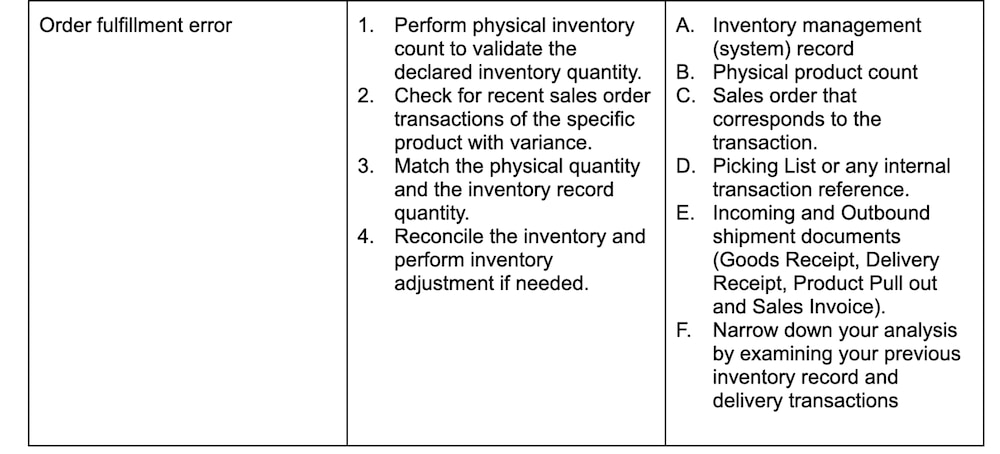
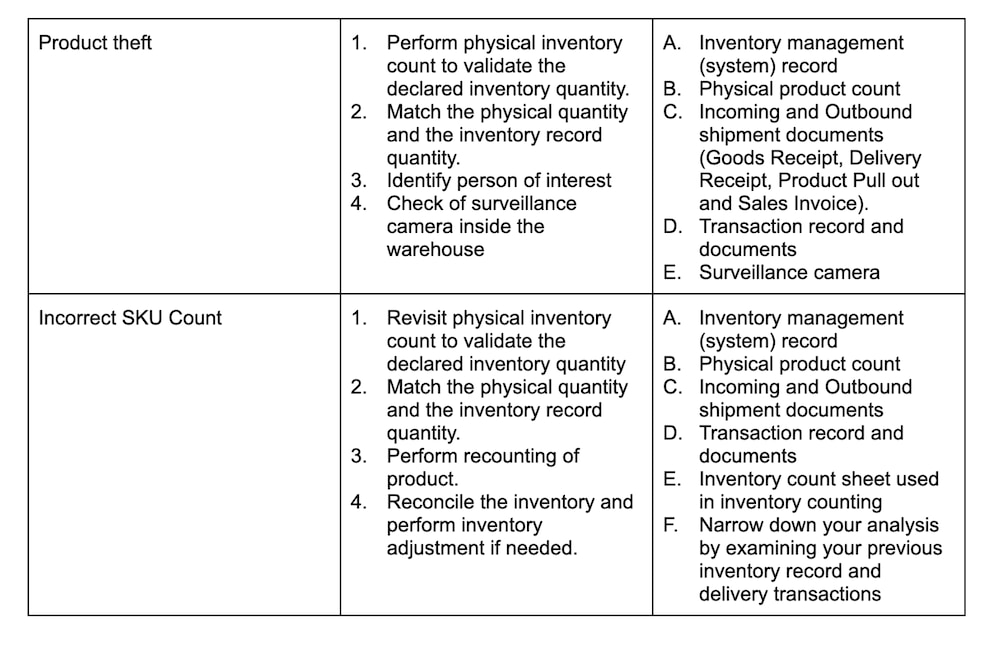
Inventory adjustment. Why, how, and when?
It is critical that inventory adjustment should be executed once the root cause of variance is identified,
A. Why do we perform inventory adjustment?
To simply correct the physical inventory and the inventory record. This is essential because if you have no inventory balance in your (POS) system, you may partially fulfill, or worse not fulfill your customer’s order. Zero inventory record means that you cannot process to allocate your product to be ordered by the customers.
B. How do we perform inventory adjustment?
The table below shows how to perform adjustment for each specific inventory variance:
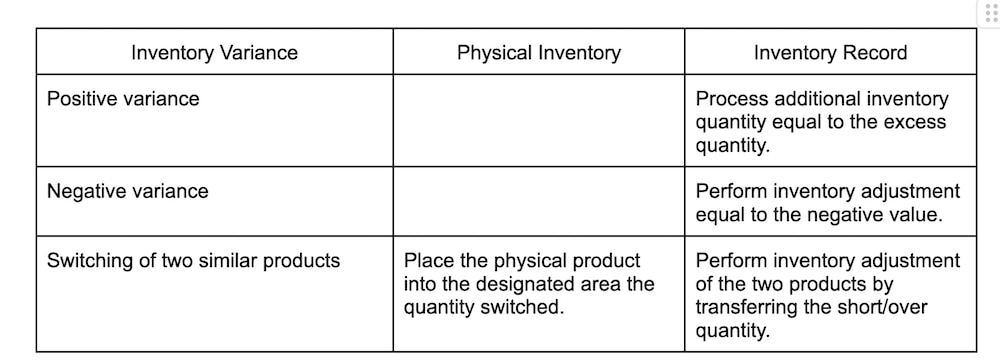
Using Figure 1 as an example, processing inventory adjustment will be as follows:
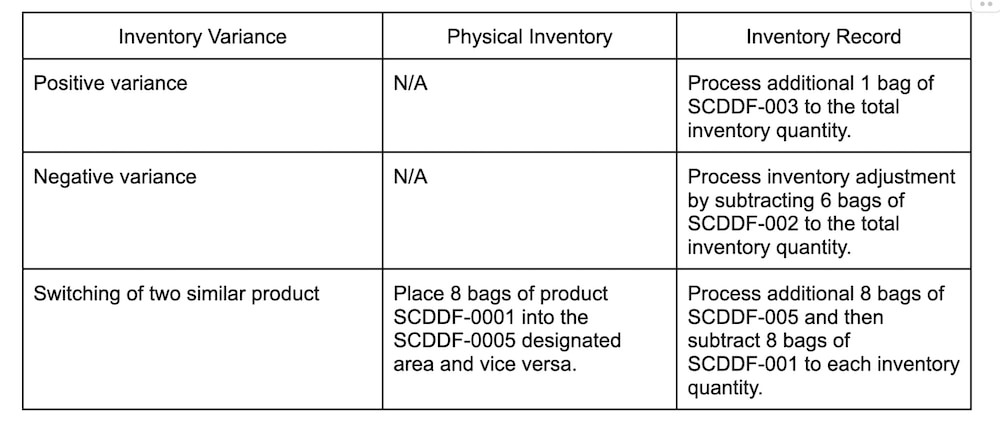
When do you perform inventory adjustment?
It is important that once the inventory count has been validated on both physical quantity and inventory record by the count team and has confirmed transactions on document and in system record, it is ideal for all stakeholders to agree on the final result.
After exhausting all possible methods of reconciliation, prepare the final inventory result. Processing of inventory adjustment should commence in order to correct and match the physical quantity and the inventory record.
Letting the inventory variance unadjusted for some time will result in operational issues like unfulfilled customer order and order backlogs. It may also result in inventory inaccuracy.
What inventory controls to use to prevent discrepancy?
Frequent Inventory Counting
Establishing inventory counting practice is the key to correct inventory variances. Practicing regular counting can greatly improve inventory accuracy, therefore, limiting the need for inventory adjustment.
There are two types of inventory counting:
- Full inventory count: This means counting all products that are stored inside your warehouse or fulfillment center. This includes all items that are on hand ready to sell.
- Inventory cycle count: This is a partial counting of your items based on your desired schedule of inventory counting. Typically, items are categorized according to class and are labeled if products are : fast, medium and slow moving items. In this method, fast moving items are frequently counted because they account for the majority of your sales and revenue.
Establishing Standard Operating Procedures
It will also be helpful to establish a standard process for all employees to follow. Having a standard process in place will minimize human error that can cause inventory variance.
Implementing Process Controls
Establish process controls in the form of a mandatory Inventory Adjustment Approval process. Inventory adjustment although necessary should not be done without any consent of the stakeholders. This is to prevent tampering of records in order to correct or align inventory records for the sake of performance. Adjustment should be processed with responsibility and integrity in order to account for all products, may it be positive or negative variance in the inventory.
Consider Regularly Reconciling Your Inventory
There are many advantages to having a regular stock reconciliation process in place:
- Avoid or minimize stock out. Unreconciled inventory may lead to a product out of stock situation in your warehouse or fulfillment center. Discrepancy that results in the lack of inventory record quantity in your point of sale system may create order backlogs or out of stock scenario. That is why it is important to regularly reconcile your physical inventory to your inventory record. Reconciling product discrepancy leads to improvement of your product fulfillment rate. Higher fulfillment rate means that you are able to fulfill customer’s orders most of the time therefore increasing customer satisfaction and brand loyalty.
- Prevent product fraud or theft. Inventory that is intact may deter incidences of internal theft. Inventory that is all accounted for regularly is a clear sign of healthy inventory performance and if there are discrepancies that are caused by theft, it will easily be detected if there is regular inventory counting conducted.
- Accurate inventory record: One of the benefits of regularly reconciling your inventory is the accuracy of the inventory record. This is the ultimate goal of every organization, to have accuracy in inventory records.
There are far more benefits of regularly reconciling your inventory, but I think the ultimate goal is that your physical inventory matches your inventory record.
This creates peace of mind in the overall logistics operations because they know they can rely on their product availability up to the last piece. The process of reconciling inventory should end by taking action on discrepancies detected during inventory counting, and that should lead to the necessary adjustment of product quantity.
I hope you found this guide helpful. I wish you all the best with your inventory management, and I encourage you to check out my other articles.
BTW – If you have a question regarding inventory reconciliation, just drop me a message:
Got A Question? Need Some Help?
Have a question about this article? Need some assistance with this topic (or anything else)? Send it in and I’ll get back to you personally.
Author
-

Ian, an Industrial Engineering major, brings over a decade of Supply Chain Management expertise to the table. His journey spans 12 years across various sectors, particularly in multinational FMCG companies where he managed extensive warehouse operations. A pro in inventory, order, and transportation management, Ian is now channeling his rich experience into guiding a construction company's operations where he handles forecasting product needs for multiple warehouses across several countries.



